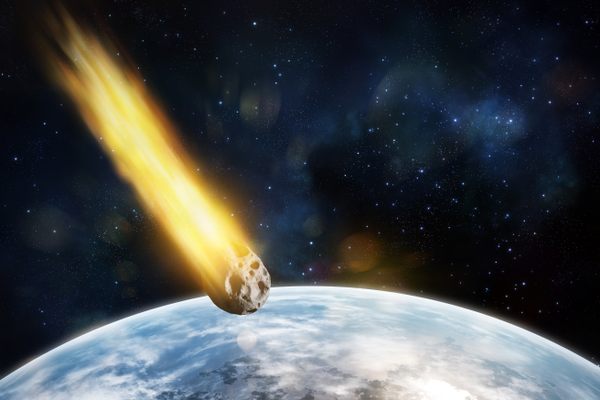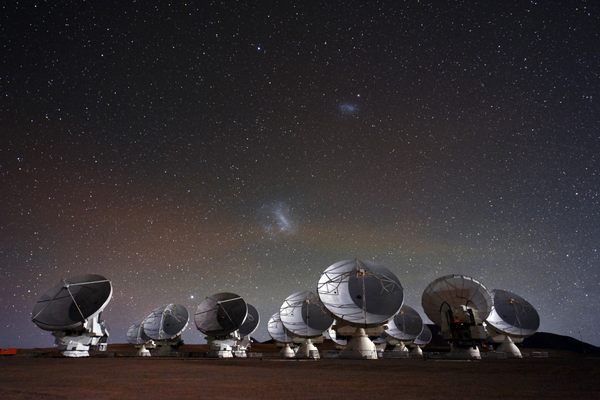Where on Earth Can You Put a Giant Telescope?
Why astronomers keep putting them in the same places.
In 1963, the astronomer Gerard Kuiper hired a plane and flew above the clouds, to circle the summit of Mauna Kea, in Hawaii. He needed a mountain, and the first one he had seen here, Haleakala, disappointed—too much fog. But Mauna Kea, the tallest mountain in the Pacific, stretched even closer toward space. The air around its cinder cone is dry and chill, the weather calm and constant. Kuiper convinced the governor of the state to help plow a rough road to the summit and then spent months collecting data about the quality of the light that shines there. In the end, he was convinced that Mauna Kea was “probably the best site in the world” for an astronomer, the perfect place to see “the moon, the planets, and the stars.” As he said at the dedication of the site—“It is a jewel!” By the end of the 1970s, four sophisticated telescopes would perch on the summit.
There are now 13 telescopes on Mauna Kea, and the international consortium building a new behemoth instrument, the Thirty Meter Telescope (TMT), plans to add another. The TMT group was convinced, just as Kuiper had been, that this would be the best site in the world for their project. They knew that it has “great cultural and archaeological significance to the local people,” but they went for it anyway. There have been extensive legal battles with locals who want protect the site’s heritage, and construction was halted. In the most recent development, management of the peak will be transferred from the University of Hawaii to a new organization, the Maunakea Stewardship Oversight Authority. An emerging compromise might allow the TMT project to move forward in exchange for decommissioning several older telescopes.
All of this is worth it for the TMT group. When it set out to find a location for this unprecedented combination of optics and technology, it began by considering “all potentially interesting sites on Earth,” and ended up at perhaps the best known and most tested astronomical site on the planet. The same thing happened with another ambitious telescope project: The group building the Giant Magellan Telescope broke ground a few years ago at Las Campanas Observatory in Chile’s Atacama Desert, another of the world’s premiere astronomical sites. Of course, any billion-dollar project will want to choose the best location available. What is it about these select mountaintops that makes them so irresistible to astronomers?

It’s simple, in a way. Astronomers want to capture light, clean and clear, as it streams down to Earth from impossibly distant stars and planets and nebulae, and they want to do that as many nights as they can each year. There are some obvious factors that obstruct that goal. Light pollution from nearby human settlements makes it hard to see the faintest objects. Wind can rattle a telescope and affect its accuracy. Clouds get in the way, especially for telescopes that operate in the visible light spectrum in particular. Site selection begins with the places on Earth with the greatest number of cloudless nights in a year. But even that is not enough.
“Once you have a found a clear enough place, you have to find an area that has little turbulence,” explains Marc Sarazin, an applied physicist for the European Southern Observatory, in charge of site monitoring. This thermal turbulence is formed when hot and cold air masses change altitudes. “This creates what you see on a very hot summer day on the asphalt, as you drive down the road,” says Sarazin. “Everything is moving; you don’t have a sharp view. It’s the same for astronomers when they look upwards, if there are layers that have been disturbed. The stars will not be so sharp.”
This quality—the sharpness of the stars—is what astronomers call “seeing,” and it’s one of the most important criteria in selecting a site. But there are other details to consider, as well. Air that’s full of water vapor can fog and frost up instruments and disrupt the view of light in the infrared spectrum. Radio waves and microwave radiation can mess with telescopes, and a place that heats up during the day and cools down at night can be a problem, too.
Some of these parameters change depending on what type of observations astronomers are looking to make. An infrared telescope project might trade more cloudy nights, which are less of a concern for that end of the light spectrum, for a site with less humidity. “It’s all a matter of compromises,” says Sarazin.
On top of all that, it helps if the people running and using the telescopes can get there with relative ease, which means roads. Astronomers and support crews need to be able to work comfortably. Mauna Kea is so high that altitude sickness slowed down the construction crews that built the first observatory there in the 1960s.
When, during the same era, Horace Babcock was looking for an observatory site in the southern hemisphere, a place where the Carnegie Institution for Science could lay the foundations for its future ambitions, he worried about the availability of water at one promising location. Las Campanas, he told an interviewer later, “right from the start, had a lot of appeal”—clear nights, excellent seeing—“except it looked as if there might be little available water.”
As basic infrastructure was built at some of these remote sites, they became even more attractive, in part because it can bring down the cost of a project. In its report on potential sites, the TMT group noted that “as a developed site with several observatories, much of the infrastructure required for TMT exists on Mauna Kea.” Las Campanas turned out to have water. And it had room for plenty of telescopes.

These days, site testers like Sarazin have a wealth of data they can use to assess potential sites without trekking up endless mountaintops. As a general rule, a site tester might start with the highest mountains, with the fewest neighbors, and narrow down their choices based on further data collected at a short list of sites. And even in northern Chile, there are still hundreds of summits that could, in theory, provide good astronomical conditions.
Given all the factors and compromises, there are three main types of places in the world that are most suited for telescopes observing visible light. One is Antarctica—the high peaks of arid plateaus have little turbulence and are surrounded by darkness. Conditions are brutal, but, advocates argue, sending a telescope to Antarctica is cheaper than sending one to space. The second is mountainous coastal areas, where the wind comes from the sea, minimizing turbulence whipping over the peaks. Chile fits this description. The third is an isolated mountain on a island, where all other conditions are right. Hawaii has mountains just like that. So does the Canary Islands. And that’s about it.
Astronomers do entertain the possibility that prime sites exist elsewhere. The TMT researchers noted that Uzbekistan has an excellent, unnamed site, and that northern Mexico and northern Africa have potential as well. There’s some interest in Mount Kenya, and China may have any number of good sites. But the most obvious and most desirable places to put giant optical telescopes haven’t changed since the 1960s and 1970s.
“No one has ever done a comprehensive survey of the planet,” says Sarazin. “We cannot say that we have looked everywhere. We know more or less the areas which could provide sites, but individual mountains have not been all characterized, of course. So there is still work for site testers.”
This story originally ran in 2018; it has been updated for 2023.


























Follow us on Twitter to get the latest on the world's hidden wonders.
Like us on Facebook to get the latest on the world's hidden wonders.
Follow us on Twitter Like us on Facebook